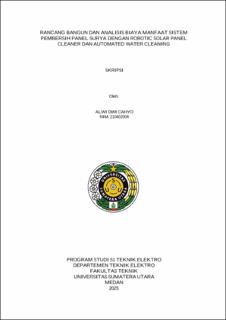Rancang Bangun dan Analisis Biaya Manfaat Sistem Pembersih Panel Surya dengan Robotic Solar Panel Cleaner dan Automated Water Cleaning
Comparative Analysis of Robotic and Water-Based Cleaning Systems for Solar Panels: Performance and Economic Feasibility

Date
2025Author
Cahyo, Alwi Dwi
Advisor(s)
Soeharwinto
Bukit, Ferry Rahmat Astianta
Metadata
Show full item recordAbstract
The transition to renewable energy, driven by environmental concerns and rising
fossil fuel prices, positions solar energy as a key solution. However, solar panel efficiency
is highly susceptible to dust and debris accumulation, which can reduce output
significantly—studies in Bahrain report that 5–12 g/m² of dust can decrease panel power by
up to 40%. This study evaluates the effectiveness and economic feasibility of two automated
cleaning systems: the Robotic Solar Panel Cleaner and Automated Water Cleaning. Three
15° tilted solar panels were tested, each covered with 10 grams of dust, clay, or sand over
three days, with parameters measured before and after cleaning. Results show that the
Robotic Solar Panel Cleaner increased average efficiency to 15.51%, while Automated
Water Cleaning reached 15.07%, both surpassing uncleaned panels at 14.10%. The robotic
system demonstrated the highest efficiency recovery across all contaminants. Financial
analysis assuming hourly cleaning indicated that only the robotic system is economically
feasible (positive NPV, BCR >1). Under a more realistic monthly cleaning scenario, both
systems’ financial performance improved, with Automated Water Cleaning becoming more
profitable (NPV Rp543,720.51; BCR 1.36; payback 9 years) than the robotic system (NPV
Rp230,998.03; BCR 1.12; payback 11 years), mainly due to lower standby power
consumption. Overall, the Robotic Solar Panel Cleaner is most effective in restoring panel
efficiency thanks to its wiper and brush mechanism and is economically viable for high-frequency cleaning scenarios.
Collections
- Undergraduate Theses [1532]
